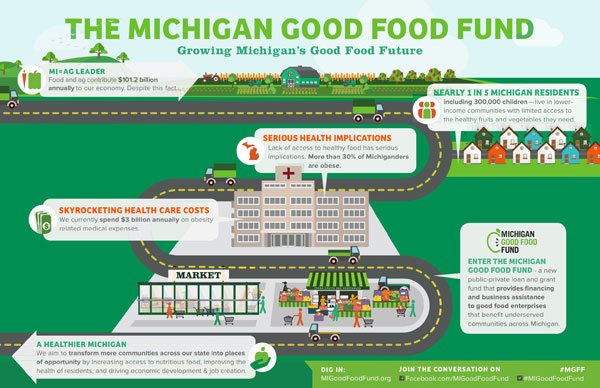
Capital Impact Partners, a community development financial institution (CDFI) that has provided over $2 billion in financing over the last three decades to support cooperative and nonprofit borrowers, has launched an offering of up to $100 million of fixed-income investment notes. These notes function like bonds. Anyone who is willing to invest at least $1,000 and who lives in one of 47 states or D.C. (the security is not registered in Arkansas, Pennsylvania, and Washington state) can purchase one of the notes. The notes will help finance the nonprofit’s “nationwide efforts to create social impact for underserved communities.”
Based in Arlington, Virginia, with offices in Oakland, California and Detroit, Michigan, Capital Impact supports underserved communities in four priority sectors—education, health care, food and housing. It also has three lending program areas that cut across sectors—lending to cooperatives (the CDFI was originally a subsidiary of the National Cooperative Bank and maintains a strong co-op lending portfolio), lending that serves older Americans, and a focused place-based initiative in the city of Detroit. Capital Impact also makes equity-like investments in social enterprise through a $5 million investment pool. Additionally, Capital Impact has a “policy to practice” program that has helped incubate new programs, some of which have led to the development of separate nonprofits, such as the Grounded Solutions Network, an association that supports the development of community land trusts across the country.
Capital Impact CEO Ellis Carr explains the nonprofit lender’s overall approach:
We’re in year two of our five-year strategic plan. We have four strategic pillars—address systemic poverty, create equity, build healthy communities, promote inclusive growth. These are all foundational to what we do. Our lending aims to provide access to quality services in communities. That could be anything from investing in a healthcare service to serve the uninsured and underinsured, could be providing access to healthy foods, supporting and preserving affordable housing by working with mission-driven affordable housing developers, or access to high quality education by investing in educational facilities. That in a nutshell is what we do and how we do it.
Carr adds that the roles the CDFI plays vary situationally—from being a market maker (i.e., lending where no one will lend) to being a catalyst (i.e., helping de-risk a market so that conventional lenders will make loans) to being a “community quarterback” or convener that assists with the development of community-wide strategies.
According to Carr, since the initial announcement on October 11th, the nonprofit has already attracted over $35 million in investments from both “retail” (individual) and institutional customers. Carr says that investments made so far range from $1,000 to $5 million. “And we have had a number in between. We’ve seen the full gamut thus far.”
Carr noted that before launching the community investment note, the nonprofit spent two years figuring out how to do the capital raise:
It was incumbent on us to not replicate what is on the market, but look to the future, where socially conscious sources were. We talked to family offices, individuals, pension funds…we asked what is important to you. We were told that it needed to be easily tradable. So, you can get it through Scottrade, etc. We heard that it needs to be aligned with market rate. That is very nebulous. For me, one of the things that is important is that you help contextualize the rate-of-return-to-risk profile. A great way of doing that was to link to S&P. A third thing that we heard is broad distribution. We are available in 47 states. The last piece, which we did not solve for, is daily liquidity. We do offer a range of time horizons.
In the first offering, available terms are for five years at 2.5-percent interest, seven years at 2.8-percent interest, and 10 years at 3.2-percent interest (until the note is sold, the interest rate is subject to change). The financial return is modest, but comparable to what you might get purchasing US bonds (the current 30-year bond rate is slightly below three percent). Of course, investing in a CDFI is riskier than a Treasury note, but Standard & Poor’s did give Capital Impact a high AA rating—only one level shy of its highest AAA rating, meaning that risk is relatively low. Future offerings, Carr adds, will also include options for shorter terms of one and three years.
Sign up for our free newsletters
Subscribe to NPQ's newsletters to have our top stories delivered directly to your inbox.
By signing up, you agree to our privacy policy and terms of use, and to receive messages from NPQ and our partners.
Capital Impact’s capital raise is part of a growing trend of nonprofits creating lending vehicles that are focused not just on attracting support from large foundation “impact investors” but also seek to raise socially motivated capital from the general public. Calvert has been a leader in this field, with offerings as large as $500 million and investment options as small as $1,000 (or as low as $20 via online platforms). Calvert, however, serves as an intermediary; the money it raises is reinvested in multiple CDFIs. (Calvert has also invested in local funds, such as a $100 million fund that it created with the MacArthur Foundation for the city of Chicago).
Capital Impact’s approach is more similar to the Impact Note that Enterprise Community Partners released, in that you are investing directly in the mission of a single organization. You can also find, if you look, smaller local CDFIs that are using this vehicle, such as the Washington Area Community Investment Fund (WACIF), which lends exclusively in the Washington, DC metropolitan region.
Of course, a reasonable question to ask of any CDFI is how do you balance financial return and social impact, which of course is central to the challenges the entire industry faces. Carr concedes that “it is very difficult for folks to manage a double bottom line.” The economic and social impact, Carr notes, “are not always in conflict but a lot of times they are.”
Carr adds:
For us, we have to be profitable [but] we have a balanced scorecard which starts with mission first. For example, with financing health care centers, we focus our lending to those that have high marks for the quality of their outcomes. … It’s a constant balance. When you face financial markets, you have to have good processes and a track record and look viable as a going concern. But you also have to have credibility in the places you serve … if you don’t, no one is going to come to you because you are not partnering with the community.
An example of Capital Impart Partners’ mission-related work is its newly launched Detroit Equitable Developer Initiative. The program, which will start with an initial cohort of 3-5 people in the first quarter of 2018, will provide training in the real estate development process, including project financing, general contracting, legal compliance; and on-on-one support. “At the end of that, there will be a pool of patient capital to serve as equity-like to compete for for-profit developers.” The idea, Carr says, is to “hire more people locally from Detroit so all can prosper.”
Carr notes that Capital Impact also provides both grant and loan support for the Michigan Good Food Fund—which supports all aspects of the food industry, including production, value-added (sauces, etc.) manufacture, and retail. “Really, the dollars flow through all of those. Your $1,000 could go directly to helping to provide capital to the Michigan Good Food Fund, to a small cooperative, or to help expand mental health services for a community health center.” The goal, ultimately adds Carr, is to serve the organization’s mission to help “build communities of opportunity that break barriers to success.”
Recently, Carr attended the national conference of the Opportunity Finance Network, a trade association of community development lenders like Capital Impact. Carr noted that the industry as a whole is grappling with its role in an economy marked by increasing inequality: “We are all continuing to think about how we can help support the fight against the growing inequality we see across the country. Most CDFIs grew up out of the civil rights movement. Many of us continue to think about and support social and economic justice issues. That is why we are in business. As that income inequality number continues to widen, we are very thoughtful of how we can partner with other nonprofits, for-profits, b corps, etc. We want to widen the tent even more. CDFIs have a significant role to play. A lot of the conversations I was having was how do we expand the tent.”











